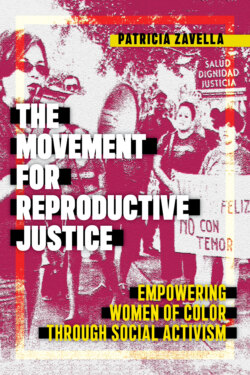Читать книгу The Movement for Reproductive Justice - Patricia Zavella - Страница 14
Overview of the Book
ОглавлениеMy overall argument in this book is the following: The organizations discussed here provide a compelling model for negotiating across difference during social activism. Further, in the current political era, in which the “war on women” and targeting of immigrants seems particularly egregious and there are widespread questions about whether “the resistance” can maintain its cohesion, the movement for reproductive justice offers a model for multiscalar politics in relation to opposing conservative agendas and the disparagement of specific social categories.
Chapter 1 explores the centrality of cultural politics, as reproductive justice organizations collaborate strategically with artists and researchers to inform specific campaigns. It discusses five initiatives that contest vilification of women of color and stereotypes about “the family” and offers alternative narratives and representations. I argue that through reframing, reproductive justice activists contest dominant thinking about women of color, serve as cultural translators of the reproductive justice framework, and promote the discourse about empowering women of color.
In chapter 2 I respond to Kimberlé Crenshaw’s query, what are intersectionality’s “ready-to-work skills?” by focusing on two campaigns run by reproductive justice activists. One is about the human right to health care in Texas that led eventually to the lawsuit Whole Woman’s Health v. Hellerstedt, and the other is about the repeal of the Maximum Family Grant (MFG) rule in California. I argue that reproductive justice activists resist conservative forces using strengths-based messaging; cross-sector collaboration, including support for one another; and strategic use of storytelling in the context of safer spaces.
Chapter 3 focuses on youth mobilization by three different reproductive justice organizations that use the language of youth empowerment. I argue that increasingly storytelling is becoming a methodology within the movement for reproductive justice, and I illustrate how organizations train youth to use narratives to convey analyses of social problems and to garner support from policy makers and community members for specific policy changes. Youth’s participation in reproductive justice youth programs helps them to navigate the transition to adulthood with the understanding that true empowerment addresses structural inequalities.
Chapter 4 explores the framing “from self-care to healing justice” by drawing on Gloria Anzaldúa’s thinking about spiritual activism. I present four cases of self-care as well as public practices that help communities heal from historical trauma. I argue that the work of self-care and spiritual activism in communities of color contests the individualism embedded in neoliberal health-care systems and instead crafts the collective politics of healing justice.
The conclusion reflects on how the movement for reproductive justice addresses the increased polarization of politics around immigration and reproductive rights in the wake of the election of President Trump. I argue that women of color in the movement for reproductive justice craft a politics of inclusion that aims to empower those who are marginalized by intersecting systems of power. These activists insist that poor women of color have the human right to healthy lives and access to health care with dignity as well as the right to health itself.
